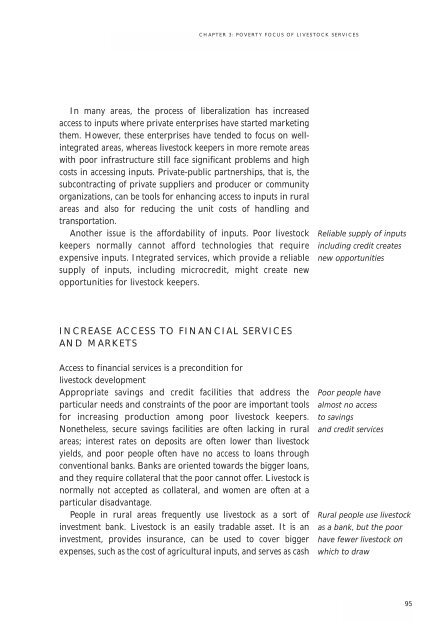Livestock Services and the Poor: A global initiative - IFAD
Livestock Services and the Poor: A global initiative - IFAD
Livestock Services and the Poor: A global initiative - IFAD
You also want an ePaper? Increase the reach of your titles
YUMPU automatically turns print PDFs into web optimized ePapers that Google loves.
CHAPTER 3: POVERTY FOCUS OF LIVESTOCK SERVICES<br />
In many areas, <strong>the</strong> process of liberalization has increased<br />
access to inputs where private enterprises have started marketing<br />
<strong>the</strong>m. However, <strong>the</strong>se enterprises have tended to focus on wellintegrated<br />
areas, whereas livestock keepers in more remote areas<br />
with poor infrastructure still face significant problems <strong>and</strong> high<br />
costs in accessing inputs. Private-public partnerships, that is, <strong>the</strong><br />
subcontracting of private suppliers <strong>and</strong> producer or community<br />
organizations, can be tools for enhancing access to inputs in rural<br />
areas <strong>and</strong> also for reducing <strong>the</strong> unit costs of h<strong>and</strong>ling <strong>and</strong><br />
transportation.<br />
Ano<strong>the</strong>r issue is <strong>the</strong> affordability of inputs. <strong>Poor</strong> livestock<br />
keepers normally cannot afford technologies that require<br />
expensive inputs. Integrated services, which provide a reliable<br />
supply of inputs, including microcredit, might create new<br />
opportunities for livestock keepers.<br />
Increase Access to Financial <strong>Services</strong><br />
<strong>and</strong> Markets<br />
Access to financial services is a precondition for<br />
livestock development<br />
Appropriate savings <strong>and</strong> credit facilities that address <strong>the</strong><br />
particular needs <strong>and</strong> constraints of <strong>the</strong> poor are important tools<br />
for increasing production among poor livestock keepers.<br />
None<strong>the</strong>less, secure savings facilities are often lacking in rural<br />
areas; interest rates on deposits are often lower than livestock<br />
yields, <strong>and</strong> poor people often have no access to loans through<br />
conventional banks. Banks are oriented towards <strong>the</strong> bigger loans,<br />
<strong>and</strong> <strong>the</strong>y require collateral that <strong>the</strong> poor cannot offer. <strong>Livestock</strong> is<br />
normally not accepted as collateral, <strong>and</strong> women are often at a<br />
particular disadvantage.<br />
People in rural areas frequently use livestock as a sort of<br />
investment bank. <strong>Livestock</strong> is an easily tradable asset. It is an<br />
investment, provides insurance, can be used to cover bigger<br />
expenses, such as <strong>the</strong> cost of agricultural inputs, <strong>and</strong> serves as cash<br />
Reliable supply of inputs<br />
including credit creates<br />
new opportunities<br />
<strong>Poor</strong> people have<br />
almost no access<br />
to savings<br />
<strong>and</strong> credit services<br />
Rural people use livestock<br />
as a bank, but <strong>the</strong> poor<br />
have fewer livestock on<br />
which to draw<br />
95

















